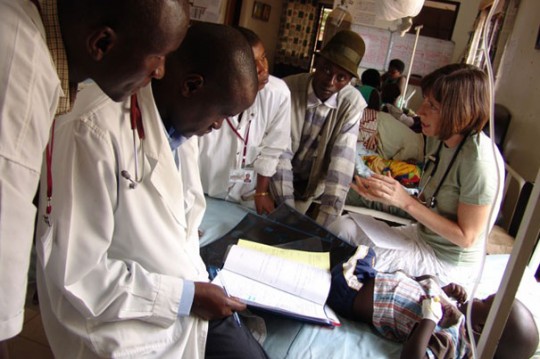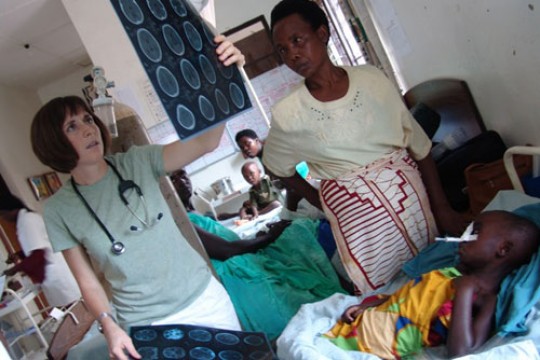Harvard professors partner in unique approach
Harvard professors partner in unique approach
U.S.-based and Rwandan physicians work to treat cancer in children
 Sara Stulac (right), consults with colleagues at the Rwinkwavu Hospital in Eastern Rwanda. Stulac, who is a Harvard Medical School instructor in medicine and the director of pediatrics for Partners In Health, has designed a program that brings together Rwandan physicians with Boston-based pediatric oncologist./ Photos courtesy of Partners In Health
Sara Stulac (right), consults with colleagues at the Rwinkwavu Hospital in Eastern Rwanda. Stulac, who is a Harvard Medical School instructor in medicine and the director of pediatrics for Partners In Health, has designed a program that brings together Rwandan physicians with Boston-based pediatric oncologist./ Photos courtesy of Partners In Health
SAN DIEGO — In an African country lacking any specialists in children’s cancers, a team approach that “twins” Rwandan physicians with Boston-based pediatric oncologists has shown it can deliver expert, curative care to young patients stricken with lymphoma.
The first-of-its-kind strategy is credited for curing at least five of 10 children at a rural Rwandan hospital; two others are in remission while receiving chemotherapy, and three children have died. The long-distance team approach was designed by Harvard Medical School (HMS) Instructor in Medicine Sara Stulac, who is also the director of pediatrics for Partners In Health.
During the past year, the program further developed and formalized through a partnership with pediatric oncologist Leslie Lehmann, an HMS assistant professor of pediatrics, Kathleen Houlahan, pediatric oncology nurse and nurse director of the Jimmy Fund Clinic at Dana-Farber/Children’s Cancer Center, and Larry Shulman, medical oncologist and chief medical officer of Harvard-affiliated Dana-Farber Cancer Institute and an associate professor of medicine at HMS.
Lehmann presented the results at the American Society of Hematology’s annual meeting Monday in San Diego.
 The “twinning” team approach leverages in-country medical and nursing resources by adding the long-distance supervision and treatment-planning of Dana-Farber/Children’s pediatric specialists in blood cancers. Key in development of the program was Sara Stulac (left).
The “twinning” team approach leverages in-country medical and nursing resources by adding the long-distance supervision and treatment-planning of Dana-Farber/Children’s pediatric specialists in blood cancers. Key in development of the program was Sara Stulac (left).
“We show that we can safely deliver care using this model — an American-trained pediatrician supervising a Rwandan-trained generalist — who are together supervised through phone calls from a U.S-based pediatric oncologist,” says Lehmann, who is clinical director of the pediatric stem cell transplant program at Dana-Farber/Children’s Hospital Cancer Center.
While nations in the developing world have traditionally devoted their limited public health resources to epidemic infectious diseases such as malaria and diarrhea, life-threatening noncommunicable conditions like cancer and heart disease are of growing concern.
“There are not enough pediatric oncologists in the world” to provide specialized cancer care for children in developing countries, Lehmann says. “And there’s not a single trained pediatric oncologist in Rwanda,” a country of more than 11 million people.
In the Western world, 80 percent of children can be cured of lymphoma, but this success rate requires definitive diagnosis, expert administration of chemotherapy, and experienced follow-up care. The “twinning” team approach leverages in-country medical and nursing resources by adding the long-distance supervision and treatment-planning of Dana-Farber/Children’s pediatric specialists in blood cancers.
The children described in Lehmann’s report were treated over the past four years at the Rwinkwavu government hospital in rural Rwanda. The hospital is supported by PIH, which was co-founded by Paul Farmer, the Kolokotrones University Professor of Global Health and Social Medicine at Harvard Medical School, where he also heads the Department of Global Health and Social Medicine.
About five years ago, Stulac, a pediatrician then based in Rwanda as the clinical director for Partners In Health’s project, set up the care model based at Rwinkwavu, along with Sara Chaffee of Dartmouth-Hitchcock Medical Center. Rounding out the group are Alain Uwumugambi, a general physician trained in Rwanda; Merab Nyishime, head pediatric nurse at Rwinkwavu Hospital; and a Rwandan nurse coordinator, Jean Bosco Bigirimana. All are authors on the paper.
Lehmann says that accurate diagnosis of lymphoma is essential and sometimes difficult. “You don’t want mistakes,” she emphasizes. Children underwent biopsies and staging X-rays in Rwanda, and the results were sent to Harvard-affiliated Brigham and Women’s Hospital in Boston for all diagnoses.
Next, the pediatric oncologist (Lehmann) oversaw the development of a treatment plan. Patients received surgery at the national referral hospital, as needed. When a patient required chemotherapy, the drugs were prescribed by one of the U.S.-trained pediatricians, and administered by Rwandan nurses under the supervision of the local general physician and supported by the American-trained pediatrician, Lehmann explained.
For radiation therapy, children were taken to facilities in bordering Uganda. Throughout treatment, Lehmann consulted with the team in weekly conference calls — or more often, if needed.
“This is the beginning of a new model,” says Lehmann. “In the past, doctors weren’t comfortable having complicated oncology care delivered without a local oncology specialist available. Having a specialist on-site would be ideal — but as global health moves into oncology, there are not enough oncologists to provide that kind of care so alternative approaches must be developed and carefully assessed.”
The study was funded by Partners In Health.
###
About Harvard Medical School (HMS)
Driving Change. Building Momentum. Making History.
Since 1872, Harvard Medical School has been the incubator of bold ideas—a place where extraordinary people advance education, science and health care with unrelenting passion.
###
About Harvard School of Public Health (HSPH)
Harvard School of Public Health is dedicated to advancing the public’s health through learning, discovery and communication. More than 400 faculty members are engaged in teaching and training the 1,000-plus student body in a broad spectrum of disciplines crucial to the health and well being of individuals and populations around the world. Programs and projects range from the molecular biology of AIDS vaccines to the epidemiology of cancer; from risk analysis to violence prevention; from maternal and children’s health to quality of care measurement; from health care management to international health and human rights.
###
* The above story is adapted from materials provided by Harvard University
_________________________________________________________________




















